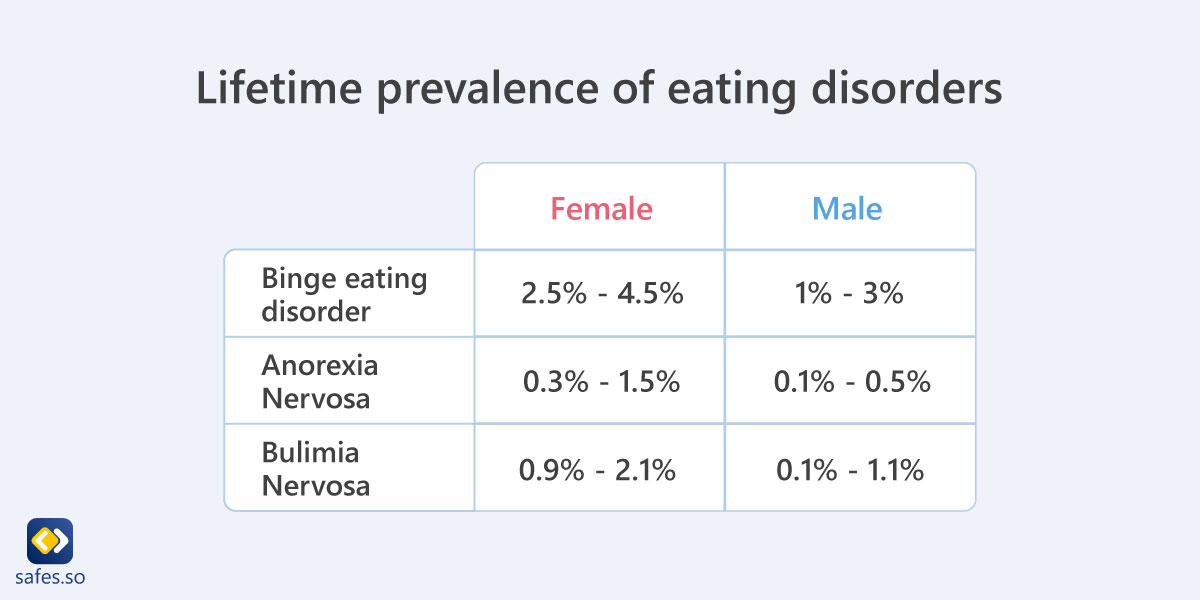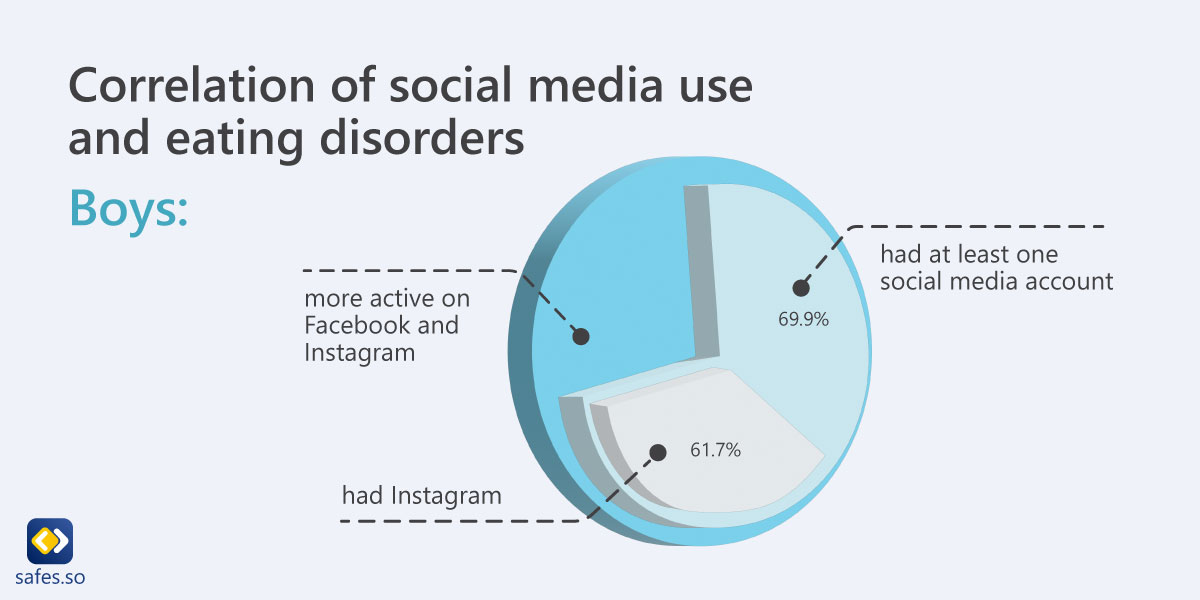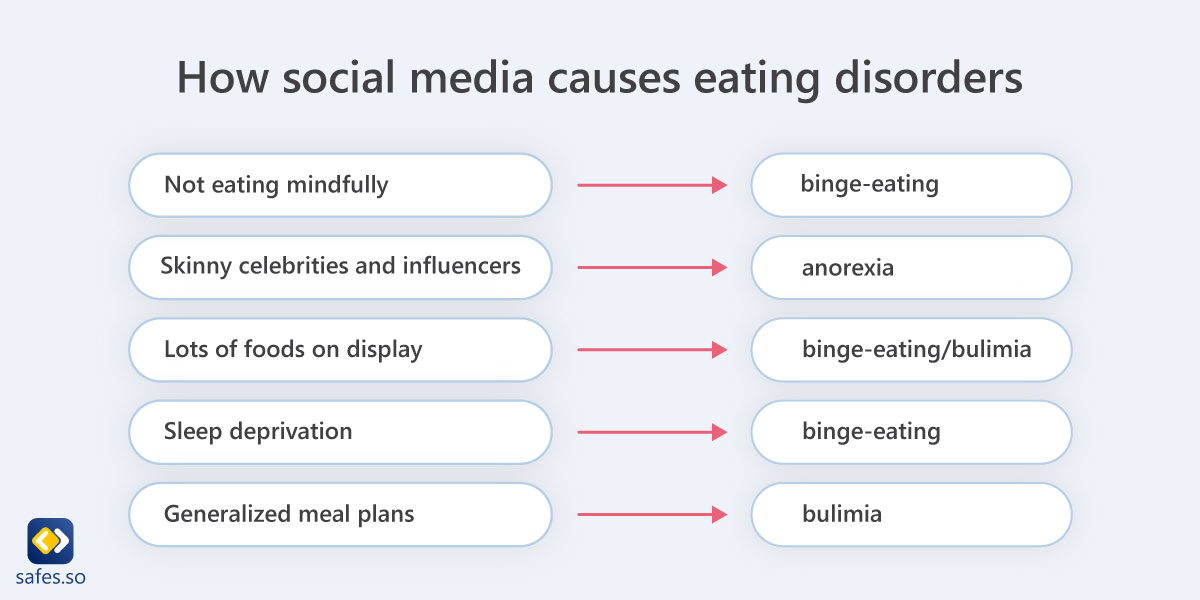Children and adolescents are growing up in a world where they get overwhelmed with mass media every day. Statistics reveal that a child or adolescent spends an average of six to seven hours a day viewing various media. Several articles have indicated a link between how the media shows the thin female beauty ideal and the muscular male body ideal, and a variety of psychological symptoms, including body dissatisfaction and eating disorders. In this blog, we are going to delve into some social media and eating disorders statistics.
What Is an Eating Disorder?
Collins defines an ED (eating disorder) “as a medical condition in which a person does not eat in a normal or healthy way”. Eating disorders are often developed due to overthinking body weight, body shape, and food. Change in eating behavior often results in nutritional deficiencies that can eventually lead to serious illnesses. Eating disorders are common among adolescents and young adults. The most common eating disorders are binge-eating disorder, anorexia nervosa, and bulimia nervosa.
Different Types of Eating Disorders
Shanghai Yangpu District Central Hospital did multiple studies on the lifetime prevalence of eating disorders, the results are shown in the infographic below. The lifetime prevalence of eating disorders is the proportion of the population that at some point in their life has experienced an ED.

Binge-Eating Disorder
People with binge-eating disorders overeat regularly and do not try to burn extra calories. The frequency of binge-eating episodes is mostly once a week. People with this disorder are often overweight or obese.
Anorexia Nervosa
People with anorexia nervosa dramatically limit their consumption of food due to fear of gaining weight. This can lead to severe health complications because of excessive loss of body weight. The main factor that causes anorexia is an inaccurate perception of body weight or shape. People with this disorder are often underweight.
Bulimia Nervosa
People with bulimia nervosa episodically eat a lot of food and then try to burn the excess calories in an unhealthy way. The uncontrolled binge eating causes a feeling of guilt, which results in people forcing vomiting, heavily exercising, or using laxatives. People with this disorder often have normal body weight or are slightly overweight.

Causes of Eating Disorders
It isn’t certain what causes an eating disorder. Many experts say it might be due to a combination of environmental, biological, and psychological factors.
Genetics
According to the MRC Social Genetic and Developmental Psychiatry Centre, you are more likely to get an eating disorder if one of your family members has one. This can be caused by a genetic predisposition that is associated with eating disorders. Genetic predisposition is the increased chance of developing a disease based on the presence of certain genes. The cause of a genetic predisposition is a specific genetic variation that is inherited from a parent.
Emotional Well-Being
According to the WHO, childhood and adolescence are critical stages of life, because nearly one in two adults’ mental health issues start at 14 years old, and 75 percent are in their mid-20s. People with mental health conditions may be more likely to develop an ED. Feelings of low self-esteem and stress may also contribute to these behaviors.
Societal Pressures
The current Western ideal of body image, self-worth, and success is related to thinness and a desire to achieve this body type. This may be emphasized by pressure from the media and peers. The increase in accessibility to social media cannot go unnoticed.
Does Social Media Contribute to Eating Disorders?
According to studies, there has been a significant change in the weight and size of female and male models portrayed in western society’s media, as well as the concept of the “perfect or ideal body”. Katzmarzyk and Davis illustrated in a study that over time the cultural ideal for women’s body size and shape has become considerably thinner and leaner. Men’s body size and shape have become stronger and more muscular. They found that 70 percent of the women were underweight, and more than three out of four women’s BMI was 15 percent lower than the healthy average.
The infographic below shows the researched boys and girls who had an eating disorder. The researched population was asked whether they had a social media account and whether they had Instagram. The group of girls were more active on Snapchat and Tumblr, while the boys were more active on Facebook and Instagram. Of the girl population who had a social media account, 68.1 percent had Instagram. Of the boy population who had social media, 61.7 percent had Instagram


How Does Social Media Cause Eating Disorders
In this section, we go over how social media can cause eating disorders. Social media contributes to these issues in several ways, including:
Mindless Eating
Nowadays it is common for teenagers to watch a movie, a YouTube video, or scroll through Instagram while eating. This causes non-mindful eating, and can eventually result in binge eating.
Celebrities and Influencers
The most followed people on Instagram are a collection of slim women, and muscular men. These people can project a wrong impression of the ideal body type. A lot of teenagers and children are unaware that these influencers edit a lot of their photos. They often have a skilled team to take the best picture of them and edit every little “imperfection”. In addition, they often have a team of personal trainers and health specialists watching over their health.
Lots of Foods on Display
There are a lot of food bloggers, especially on Instagram. These people make videos and photos of delicious recipes and put them on display. The more you look at this food content, the hungrier you’ll get. This can cause binge eating, and when it is paired with guilt after an episode it can result in bulimia.
Sleep Deprivation
One of the negative effects of social media on your child is sleep deprivation. Because of the continuous scrolling and checking of their phones, their sleep might get sacrificed. Research has shown that a lack of sleep can cause binge eating and making unhealthy food decisions.
Personal Trainers
Since the COVID-19 outbreak online personal trainers and “food experts” have become increasingly more active. A lot of these online personalities give out free generalized meal plans, your teenager can be tempted to use these. These meal plans can be presented as a weekly or monthly challenge, and the influencer has planned what foods to eat at any time of day. These plans seem to offer some sort of benefit for your child, but because they are not personalized it’s more harmful than beneficial. 
Help Your Child
Children can create a social media account on their thirteenth birthday. When they create an account, a pop-up appears asking them to verify that they are actually 13. They can verify this even if they have not yet reached that age, there is no proper control. There are safe social media platforms for children that your child can use without you worrying about the negative effects of these platforms.
To help your child and prevent social media from causing an eating disorder, you can think about limiting social media or using therapy. Medication has shown little effectiveness in the treatment of anorexia, but some medications seem to be effective in treating bulimia.
Therapy
Cognitive behavioral therapy (CBT) is a combination of behavioral modification techniques and talk therapy. CBT can address previous trauma or question the motivation behind extreme weight loss. The therapist will help your child to deal with possible triggers. For children and adolescents, it can be beneficial to get into family therapy to improve communication between the child and parents.
Medication
Few trials showed that Olanzapine may stimulate appetite and encourage eating in people with anorexia. People with bulimia can be treated with selective serotonin reuptake inhibitors (SSRIs) to help treat underlying mental health disorders and reduce bingeing-purging cycles. Other antidepressants like monoamine oxidase inhibitors and tricyclic antidepressants have shown to reduce bingeing-purging cycles as well.
Limit Time on Social Media
The time limit on social media can be set up with parental controls. A parental control app that can help you is Safes. With Safes it is possible to not only limit time on social media apps but you can also:
- Receive detailed activity reports: Parents get informed about their children’s devices and internet usage and about the content they consume.
- Filter website content: This feature blocks out inappropriate websites. Parents can also select specific content categories.
- Track your child’s location: Children’s live location is shown and their movements will be logged.
Download Safes to try out all the features to protect your child and start your free trial of Safes to gain peace of mind with advanced parental control features.




